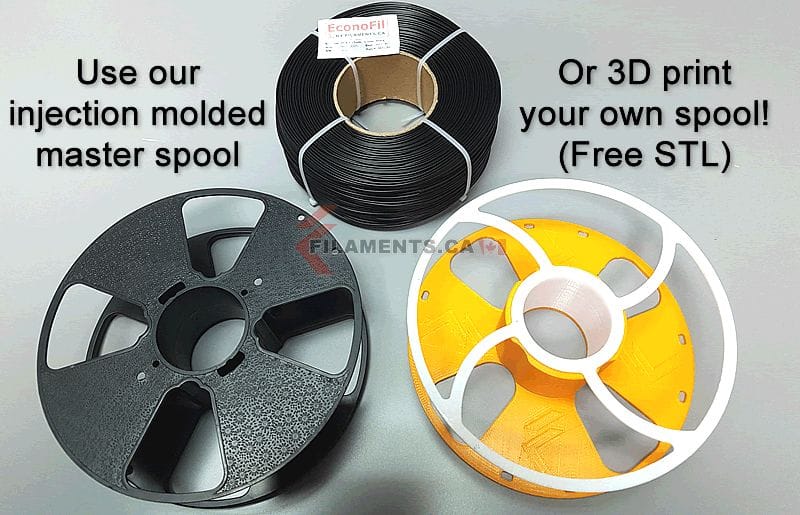
Yet another “master spool” concept has been released.
This time it’s from Canadian filament reseller Filaments.ca, who have introduced what they call the “REFILL” system, designed to operate with their unspooled “EconFil” filament offerings.
The idea of using a generic reusable spool emerged a few months ago. The process is quite simple: 3D print your own spool with a design that includes two attachable halves. Then buy a coil of filament – without spool – at lower cost, and install it in the reusable spool.
This approach is quite beneficial, not only because of lower costs – and potentially shipping costs, too, I should add, but because you don’t end up with mountains of empty, unusable spools. I know in my case I was considering donating a pile to artists so they could “make something nice with them”. I’d love to get rid of the empty spool problem.
We then saw Richard Horne introduce his MasterSpool concept a few months ago. Then just a couple of weeks ago US-based Keene Village Plastics introduced their KOIL system, with a similar reusable spool concept, but with somewhat different dimensions. I wondered whether we’d actually end up with a defacto standard for reusable spools if there were more than one to choose from.
Now we see a third major venture into this problem space from Filaments.ca, who now offer a downloadable/printable reusable spool as well as their own pre-made injection molded version.
I presume it’s relatively easy for a 3D print filament vendor to produce such a system, because they can also buy or produce their stock at lower cost without spools. And the design and distribution of a master spool 3D model is straightforward: MasterSpool and the Filaments.ca spools are available on Thingiverse right now, but KVP’s files are not and you must go to their site to download them.
I am really hoping this world consolidates into a standard master spool format, because of another issue: mounting.
Mounting a spool of filament on a 3D printer depends on the key dimensions of the spool:
- The outer diameter
- The width
- The inner “hole” diameter
Most 3D printers have some method of mounting spools, but all of these approaches make assumptions of the dimensions of the spools to be used. In some cases the assumption is that the dimensions will be those of their preferred filament supplier. But in real life, people buy filament from many sources. I can’t tell you the number of differently dimensioned spools I’ve used (and still have a pile of empties from).
Whenever you encounter a spool with different dimensions, you have to re-engineer your spool mounting system, and it’s a pain to do so. While some third party add-on mounting systems are adjustable to accommodate differently sized spools, you still have to make the adjustment. It’s work that no one really needs to do – if everyone agreed on a standard spool format.
But the announcement from Filaments.ca suggests that each 3D printer filament vendor may soon release their own spool system, potentially with different dimensions.
Rather than living in a master spool universe, we apparently will continue to live in a multi-spool universe. Sigh.
Via Filaments.ca

